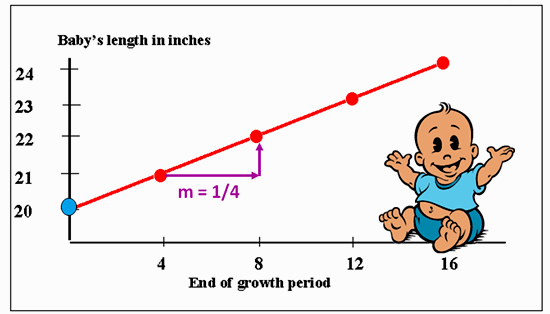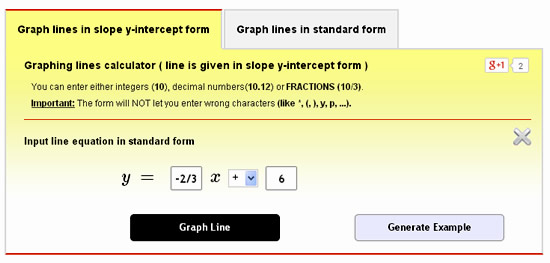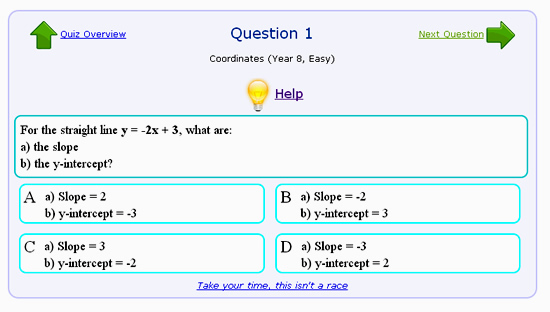Babies usually follow a straight line of increasing body length as they start growing.
This baby was born 20 inches long (y-intercept), and has been growing at a rate of a 1/4 inch per week.
There are many other important Straight Line Relationships in Real Life, as shown in our previous lessons at the links below:
In this lesson we cover the following:
– Gradient-Intercept Equation Form
– Identifying Gradient and Y-Intercept
– Rearranging Into y = mx + b Form
– Finding the Line Equation from a Graph
– Graphing y = mx + b
– Graphs with Y-Intercept at Zero
– Horizontal and Vertical Lines
As you can see, it is a big lesson containing several related items, and so work through everything very carefully, and make sure you watch the Videos.
Gradient-Intercept Equation Form
Let’s begin by looking at what is Gradient-Intercept Equation Form.
Depending on what country you are in, the equation may vary, but in both formats it says that the value of every Y-Coordinate can be found by taking the X-Coordinate multiplied by the Gradient Slope and then adding on the Y-Intercept value.
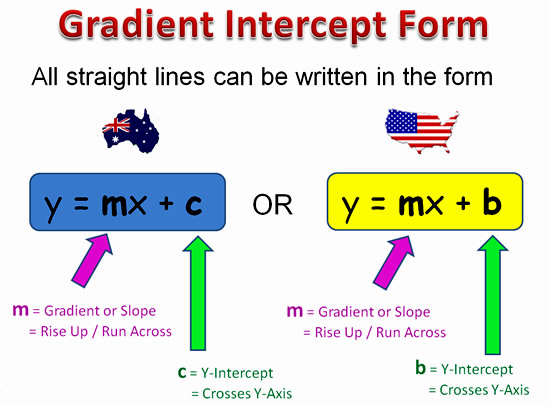
Image Copyright 2013 by Passy’s World of Mathematics
Identifying Gradient and Y-Intercept
If we are given a Line Equation in y = mx + b form, we can find the Slope and Y-Intercept, without drawing any graphs.
We simply take the number or fraction value in front of “x”, and this is the Gradient Slope.
The number or fraction value on the end of the equation is the Y-Intercept.
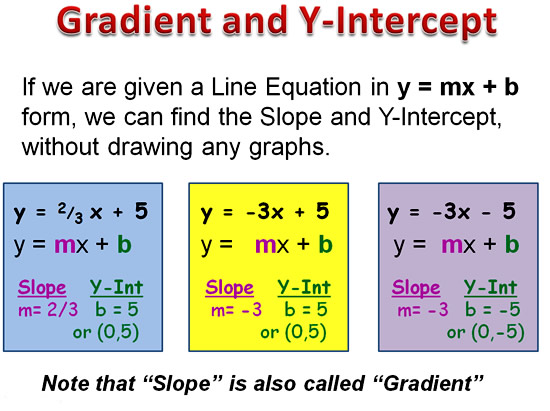
Image Copyright 2013 by Passy’s World of Mathematics
Rearranging Into y = mx + b Form
Often we have equations such as 5x + 3y = 15, we need to rearrange the equation into y = mx + b format.
We do this by solving the equation for “y”
Here is a video which shows how to rearrange equations into y = mx + c form, by applying opposite operations to both sides
We can then find the Gradient Slope, and the Y-Intercept, without having to draw any graphs.
Here are a couple of examples of Rearranging into y = mx + b form.
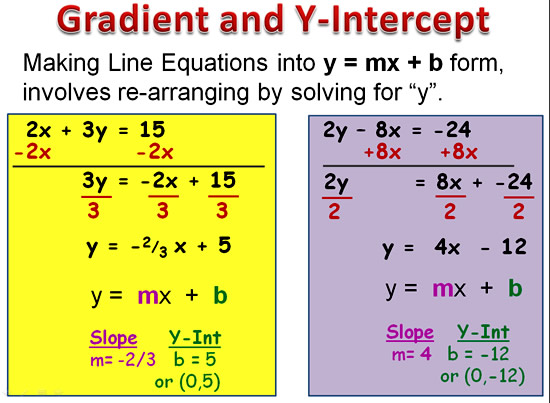
Image Copyright 2013 by Passy’s World of Mathematics
Finding the Line Equation from a Graph
If we are given a Line Graph, we can read off the Y-Intercept and Calculate the Gradient Slope.
We then substitute these values for “m” and “b” in the y = mx + b equation.
Eg. We replace the “m” and the “b” in y = mx + b with our values taken from the graph.
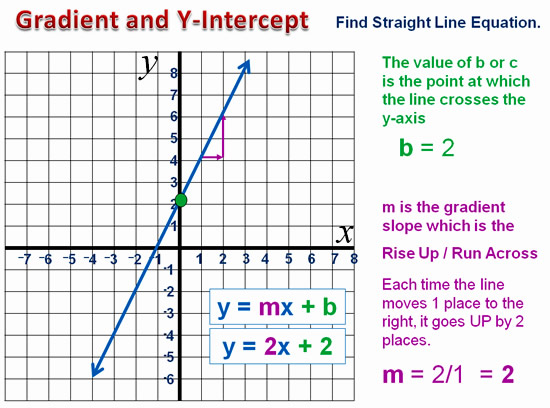
Image Copyright 2013 by Passy’s World of Mathematics
Graphing y = mx + b
There are four steps to making the Straight Line Graph:
1. Rule up and Label an X-Y Cartesian Grid
2. Line up the equation with y = mx + b and read off the Y-Intercept as the number matching up with “b”.
Dot in this y intercept value as a point on the Y-axis.
3. Take the value in front of “x” as the Gradient, and write it as an UP/Across fraction. (Eg. If we have 3x, write the Gradient as 3/1).
From the Y-intercept, move UP (or DOWN if negative), and then Across, and make another dot on the Grid.
4. Join the two dots with a line including arrow ends,and then write the equation of the line next to the line.
Here is a two minute video showing how to do the above four steps to graph a line which is in y = mx + b form.
Keep in mind the four steps, whenever graphing y = mx + b equations.
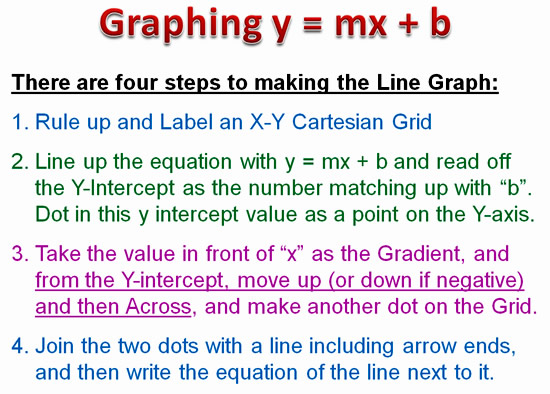
Image Copyright 2013 by Passy’s World of Mathematics
Example Graph for y = 2x + 2
Our first steps are to rule up a Cartesian Grid, and then mark a dot on it for the y-Intercept.
Basically the number or fraction at the end of the equation gets marked onto the Y-axis.
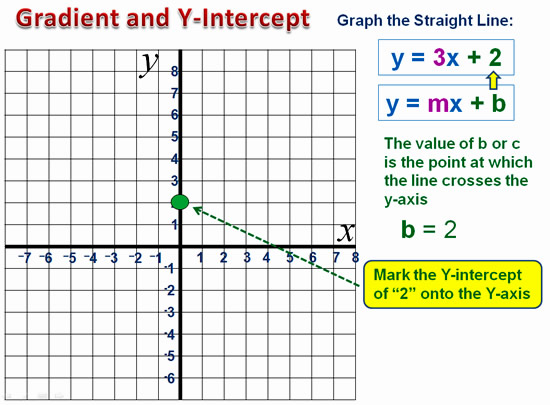
Image Copyright 2013 by Passy’s World of Mathematics
The next step is to use the Gradient Slope value to plot a second point onto the Grid.
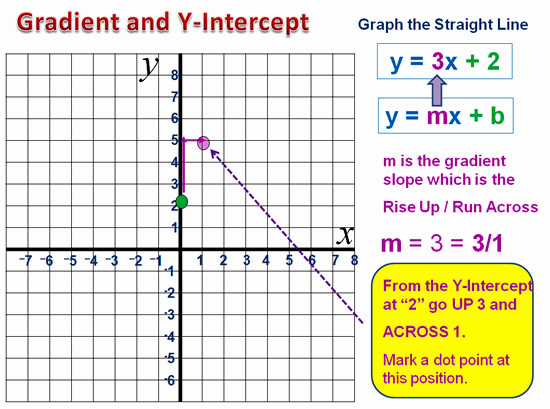
Image Copyright 2013 by Passy’s World of Mathematics
Now all we need to do is dot to dot join our two points with a straight line.
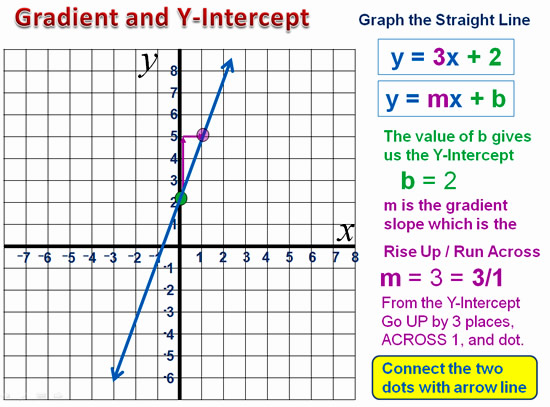
Image Copyright 2013 by Passy’s World of Mathematics
Video on Graphing Straight Lines
This next video is a longer video and shows how to do graphs for a number of equations which are in y = mx + b form.
Practice Grid
Here is a blank Practice Grid to plot some y = mx + b Straight Lines.

Image Copyright 2013 by Passy’s World of Mathematics
Graphs with Y-Intercept at Zero
Some equations do not have a “b” number or fraction value on the end of them.
Eg. y = 2x, y= -4x, y=3x, y= -3x, y = 2/3 x, y = -3/4 x, y = 7x, etc
This simply means that the Y-Intercept is zero.
We therefore do a dot in the middle of the X-Y Cartesian Grid to mark in Y-intercept = 0.
Then all we have to do is use the Gradient Slope value to move from zero up or down to a second position and make a dot there.
Finally we join these two points to make the line.
Here is an example showing how we have plotted the graph of y = 3x.
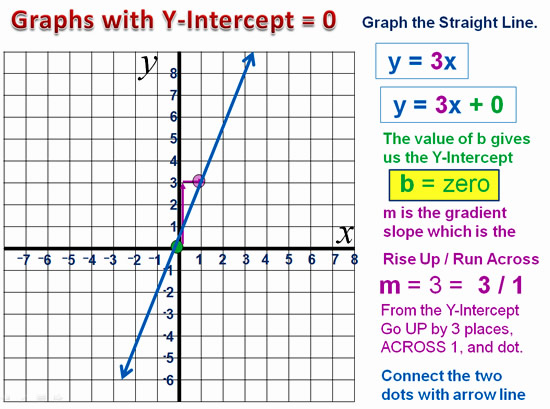
Image Copyright 2013 by Passy’s World of Mathematics
In this second example y = -3/4x we have a NEGATIVE gradient, and so we need to move DOWN and then across.
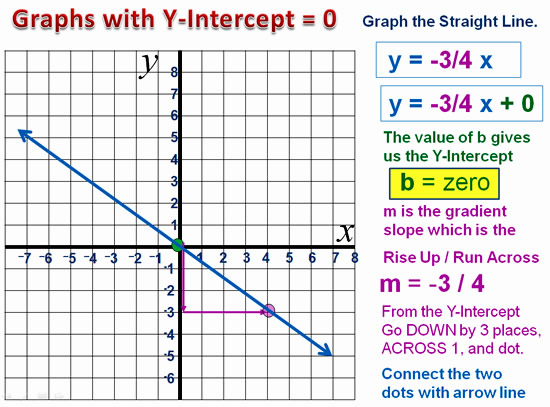
Image Copyright 2013 by Passy’s World of Mathematics
Vertical and Horizontal Lines
Two types of lines which do not have a Gradient Intercept form equation are Vertical Lines and Horizontal Lines.
Eg. Their Line Equations cannot be written in y = mx + b form.
Vertical Lines cannot be written in y = mx + b form, because their Gradient Slope if undefined, and the lines go infinitely straight up.
Vertical Lines have equations such as x = 2, x = -3, x=7, x = -4, etc.
Vertical Lines have an X-Intercept, but they do not have a Y-Intercept.
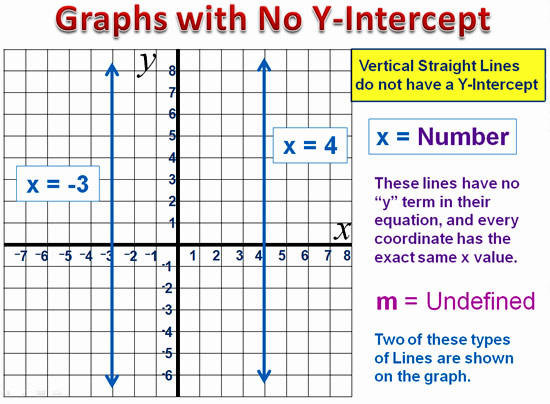
Image Copyright 2013 by Passy’s World of Mathematics
Horizontal Lines have Zero Gradient Slope, because they are not going uphill, and they are not going downhill, they are going along flat.
Horizontal Lines have line equations such as y = 1, y = 6, y = -3, y = -5 etc.
Because Horizontal Flat Lines have a Gradient of zero, y = 0x + b simplifies to y = b
Horizontal Lines have a Y-Intercept, but do not have an X-Intercept.
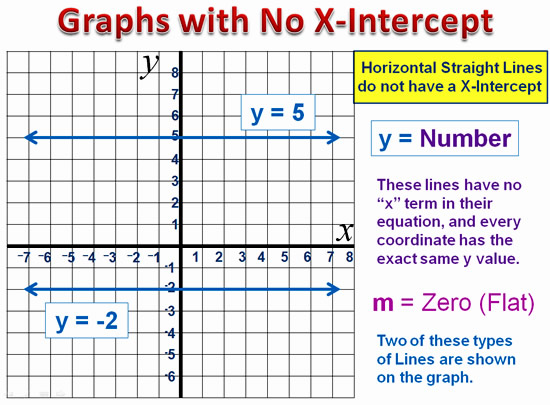
Image Copyright 2013 by Passy’s World of Mathematics
The following video shows how to graph Horizontal and Vertical Lines on an X-Y Cartesian Grid, and then shows how to do these same lines on a Texas Instruments graphing calculator.
This next video shows how to determine the equations of Horizontal and Vertical Lines.
Finally, here is a video which shows just how quick and easy it is to graph Vertical and Horizontal Straight Lines.
Slope Intercept Form Worksheets
The following worksheet involves drawing the graph for a number of y = mx + b Equations.
(There are answers further down on the worksheet).
Drawing the Graph for y = mx + b Worksheet 1
The following worksheet involves drawing the graph for a number of y = mx + b Equations.
However, the equations have to be rearranged into y = mx + b form first.
(There are answers further down on the worksheet).
Drawing the Graph for y = mx + b Worksheet 2
Do Questions 1 to 8 on the following Worksheet which are questions where we rearrange standard equations into y = mx + b form.
(There are answers further down on the worksheet).
Rearrange standard equations into y = mx + b form Worksheet
The following worksheet is on finding the Gradient Slope “m” directly from an equation without drawing the graph.
Some equations need to be rearranged into y = mx + b form first.
(There are answers further down on the worksheet).
Finding the Gradient Slope Worksheet
This final worksheet is on Horizontal and Vertical Lines but does not have an Answer Key on it.
Horizontal and Vertical Lines Worksheet
Online Graphing Calculator
The following Online Calculator Graphs the input Equation, and also supplies full working out with explanations of each step.
The working out is by the X and Y Intercepts method, but it will give you an accurate picture of what your graph should look like.
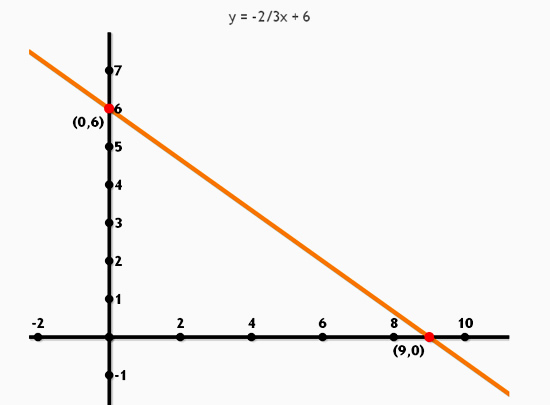
Image Copyright 2013 by Passy’s World of Mathematics
Click the following link to use the Calculator:
Click here to use the Online Graphing Tool
Online Quiz for y = mx + b
There is a great Online Quiz at the “Maths is Fun” website which you can do by clicking the link below.
The quiz also gives a complete fully worked explanation for any question you get wrong.
Click here to do the Online Quiz
Related Items
X and Y Intercepts
Gradient and Slope Formula
Gradient and Slope
Gradient and Slope in the Mountains
The Cartesian Plane
Plotting Graphs from Horizontal Values Tables
Plotting a Linear Graph using a Rule Equation
Plotting Graphs from T-Tables of Values
Finding Linear Rules
Distance Between Two Points
Mountain Gradients
Real World Straight Line Graphs I
Real World Straight Line Graphs II
Subscribe
If you enjoyed this lesson, why not get a free subscription to our website.
You can then receive notifications of new pages directly to your email address.
Go to the subscribe area on the right hand sidebar, fill in your email address and then click the “Subscribe” button.
To find out exactly how free subscription works, click the following link:
If you would like to submit an idea for an article, or be a guest writer on our website, then please email us at the hotmail address shown in the right hand side bar of this page.
If you are a subscriber to Passy’s World of Mathematics, and would like to receive a free PowerPoint version of this lesson, that is 100% free to you as a Subscriber, then email us at the following address:
Please state in your email that you wish to obtain the free subscriber copy of the “Gradient Intercept Form”
Feel free to link to any of our Lessons, share them on social networking sites, or use them on Learning Management Systems in Schools.
Like Us on Facebook
Our Facebook page has many additional items which are not posted to this website.
These include items of mathematical interest, funny math pictures and cartoons, as well as occassional glimpses into the personal life of “Passy”.
Check it out at the following link:
https://www.facebook.com/PassysWorldOfMathematics
While you are there, LIKE the page so you can receive our FB updates to your Facebook News Feed.
Help Passy’s World Grow
Each day Passy’s World provides hundreds of people with mathematics lessons free of charge.
Help us to maintain this free service and keep it growing.
Donate any amount from $2 upwards through PayPal by clicking the PayPal image below. Thank you!
PayPal does accept Credit Cards, but you will have to supply an email address and password so that PayPal can create a PayPal account for you to process the transaction through. There will be no processing fee charged to you by this action, as PayPal deducts a fee from your donation before it reaches Passy’s World.
Enjoy,
Passy

